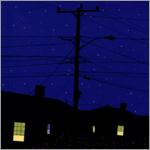 While grand flourishes and touches of color may capture your eye, asolid foundation is key to making everything work together. Subtle,almost unseen nuances set the scene for everything built upon it. Thekey is finding the right balance, to not be so subtle as to beunnoticed. On Helms' latest release, McCarthy, the band delves into those latent shades, at times almost getting lost, in order to describe themselves in a different way. McCarthyseems to evoke the moments between sleep and waking, when the conscioushasn't fully kicked in and the unconscious hasn't fully departed.Thoughts and images appear and at once evaporate, failing to make adistinct impression, only leaving a faint trace behind. Much of McCarthyevokes this ephemeral nature, each song almost blurring with the next."Singer and guitarist Sean McCarthy spills out his lyrics in a languid,sleepy manner never fully rising above the midtempo drone of bassistTina Helms and drummer Dan McCarthy. McCarthy seems to aspireto twilight, the arrangements blinking like stars peaking throughfading sunlight, establishing a melody or a riff and then shifting itup and down, back and forth, as on "It Takes Skin to Win." While thistechnique works for Helms as on the aforementioned track, it can attimes become tedious. Helms is most successful when they lurch out oftheir grogginess as on the soaring opener track, "The Hypochondriac'sLast Words," which allows vocalist Sean to show some dynamics in hisvoice. Deviations are welcome, and when "The Ten Thousand Things"arrives, it's not a moment too soon. The rhythm section chugging alongsolidly, punctuated by a thrusting crescendo of guitar that stands outagainst the albums shy demeanor. "Robots Are Great, But Are We ReadyFor Them to Dance on Their Own?" succeeds in building a compelling ideawith only a simple repeated riff, imbued with urgency and energy. Thealbum closes with the unfortunate "Cornish, New Hampshire," dragging onwith a meandering recitation of items in a drawer, daring the listenerto endure the song's seven minute duration. Despite their individualissues, the songs on McCarthy work well together to create astarry, midnight blue atmosphere that makes the album a pleasantlisten. The concern is not on specifics, but on a broader,impressionistic expression of sense and feeling. While the thoughts maydisappear as soon as we open our eyes, the feelings stay with us, thevague memories of sensation that merely hint and never tell.
While grand flourishes and touches of color may capture your eye, asolid foundation is key to making everything work together. Subtle,almost unseen nuances set the scene for everything built upon it. Thekey is finding the right balance, to not be so subtle as to beunnoticed. On Helms' latest release, McCarthy, the band delves into those latent shades, at times almost getting lost, in order to describe themselves in a different way. McCarthyseems to evoke the moments between sleep and waking, when the conscioushasn't fully kicked in and the unconscious hasn't fully departed.Thoughts and images appear and at once evaporate, failing to make adistinct impression, only leaving a faint trace behind. Much of McCarthyevokes this ephemeral nature, each song almost blurring with the next."Singer and guitarist Sean McCarthy spills out his lyrics in a languid,sleepy manner never fully rising above the midtempo drone of bassistTina Helms and drummer Dan McCarthy. McCarthy seems to aspireto twilight, the arrangements blinking like stars peaking throughfading sunlight, establishing a melody or a riff and then shifting itup and down, back and forth, as on "It Takes Skin to Win." While thistechnique works for Helms as on the aforementioned track, it can attimes become tedious. Helms is most successful when they lurch out oftheir grogginess as on the soaring opener track, "The Hypochondriac'sLast Words," which allows vocalist Sean to show some dynamics in hisvoice. Deviations are welcome, and when "The Ten Thousand Things"arrives, it's not a moment too soon. The rhythm section chugging alongsolidly, punctuated by a thrusting crescendo of guitar that stands outagainst the albums shy demeanor. "Robots Are Great, But Are We ReadyFor Them to Dance on Their Own?" succeeds in building a compelling ideawith only a simple repeated riff, imbued with urgency and energy. Thealbum closes with the unfortunate "Cornish, New Hampshire," dragging onwith a meandering recitation of items in a drawer, daring the listenerto endure the song's seven minute duration. Despite their individualissues, the songs on McCarthy work well together to create astarry, midnight blue atmosphere that makes the album a pleasantlisten. The concern is not on specifics, but on a broader,impressionistic expression of sense and feeling. While the thoughts maydisappear as soon as we open our eyes, the feelings stay with us, thevague memories of sensation that merely hint and never tell.  While grand flourishes and touches of color may capture your eye, asolid foundation is key to making everything work together. Subtle,almost unseen nuances set the scene for everything built upon it. Thekey is finding the right balance, to not be so subtle as to beunnoticed. On Helms' latest release, McCarthy, the band delves into those latent shades, at times almost getting lost, in order to describe themselves in a different way. McCarthyseems to evoke the moments between sleep and waking, when the conscioushasn't fully kicked in and the unconscious hasn't fully departed.Thoughts and images appear and at once evaporate, failing to make adistinct impression, only leaving a faint trace behind. Much of McCarthyevokes this ephemeral nature, each song almost blurring with the next."Singer and guitarist Sean McCarthy spills out his lyrics in a languid,sleepy manner never fully rising above the midtempo drone of bassistTina Helms and drummer Dan McCarthy. McCarthy seems to aspireto twilight, the arrangements blinking like stars peaking throughfading sunlight, establishing a melody or a riff and then shifting itup and down, back and forth, as on "It Takes Skin to Win." While thistechnique works for Helms as on the aforementioned track, it can attimes become tedious. Helms is most successful when they lurch out oftheir grogginess as on the soaring opener track, "The Hypochondriac'sLast Words," which allows vocalist Sean to show some dynamics in hisvoice. Deviations are welcome, and when "The Ten Thousand Things"arrives, it's not a moment too soon. The rhythm section chugging alongsolidly, punctuated by a thrusting crescendo of guitar that stands outagainst the albums shy demeanor. "Robots Are Great, But Are We ReadyFor Them to Dance on Their Own?" succeeds in building a compelling ideawith only a simple repeated riff, imbued with urgency and energy. Thealbum closes with the unfortunate "Cornish, New Hampshire," dragging onwith a meandering recitation of items in a drawer, daring the listenerto endure the song's seven minute duration. Despite their individualissues, the songs on McCarthy work well together to create astarry, midnight blue atmosphere that makes the album a pleasantlisten. The concern is not on specifics, but on a broader,impressionistic expression of sense and feeling. While the thoughts maydisappear as soon as we open our eyes, the feelings stay with us, thevague memories of sensation that merely hint and never tell.
While grand flourishes and touches of color may capture your eye, asolid foundation is key to making everything work together. Subtle,almost unseen nuances set the scene for everything built upon it. Thekey is finding the right balance, to not be so subtle as to beunnoticed. On Helms' latest release, McCarthy, the band delves into those latent shades, at times almost getting lost, in order to describe themselves in a different way. McCarthyseems to evoke the moments between sleep and waking, when the conscioushasn't fully kicked in and the unconscious hasn't fully departed.Thoughts and images appear and at once evaporate, failing to make adistinct impression, only leaving a faint trace behind. Much of McCarthyevokes this ephemeral nature, each song almost blurring with the next."Singer and guitarist Sean McCarthy spills out his lyrics in a languid,sleepy manner never fully rising above the midtempo drone of bassistTina Helms and drummer Dan McCarthy. McCarthy seems to aspireto twilight, the arrangements blinking like stars peaking throughfading sunlight, establishing a melody or a riff and then shifting itup and down, back and forth, as on "It Takes Skin to Win." While thistechnique works for Helms as on the aforementioned track, it can attimes become tedious. Helms is most successful when they lurch out oftheir grogginess as on the soaring opener track, "The Hypochondriac'sLast Words," which allows vocalist Sean to show some dynamics in hisvoice. Deviations are welcome, and when "The Ten Thousand Things"arrives, it's not a moment too soon. The rhythm section chugging alongsolidly, punctuated by a thrusting crescendo of guitar that stands outagainst the albums shy demeanor. "Robots Are Great, But Are We ReadyFor Them to Dance on Their Own?" succeeds in building a compelling ideawith only a simple repeated riff, imbued with urgency and energy. Thealbum closes with the unfortunate "Cornish, New Hampshire," dragging onwith a meandering recitation of items in a drawer, daring the listenerto endure the song's seven minute duration. Despite their individualissues, the songs on McCarthy work well together to create astarry, midnight blue atmosphere that makes the album a pleasantlisten. The concern is not on specifics, but on a broader,impressionistic expression of sense and feeling. While the thoughts maydisappear as soon as we open our eyes, the feelings stay with us, thevague memories of sensation that merely hint and never tell.  This is the second Go-Betweens album since their resuscitation threeyears ago, and the band's sound is still surprisingly consistent.During their twenty-year existence, the Go-Betweens have been thepedagogues of jangly pop, ably instructing in their art and edifyingcountless bands who have followed in their footsteps but never hopedever to overtake the teacher as would be normal in the course of thementor/apprentice relationship. The Go-Betweens maintain theirmentorship not by any tyrannical stranglehold, but rather by aperfection of pop which other bands seem unable to master (or evensometimes muster). It usually takes me a few listens through to pickout my best Go-Betweens songs from any one album, and this record is nodifferent. In the end, the differences between the songs which I likeand the ones which I just listen to are subtle; they amount to acertain inflection here, a deeper crooning there. What I can sense fromthese post-reunification albums is that the inflections and crooningshave become less intense and less intoned, for whatever reason (I don'tthink it is so much age as it is growth). As a result, fewer songs jumpout at me. The first half of Bright Yellow Bright Orangebest approaches the glory of older releases. "Poison in the Walls" willnot only recall older songs like "Part Company," but can show what Imean when I talk about the minimized inflection: the elongatedpronunciation of "sometimes" is the hallmark of great Go-Betweenssongs, but in this case is slightly less energetic than I would haveexpected or than would have been recorded circa 1984. The surface ofthe next song, "Mrs. Morgan," screams to be compared to Lou Reed, buteven his songs were never so pleasantly lackadaisical as this. Despiteall of its good, this record simply seems too summery and relaxed for aproper appreciation presently. The anxiety of winter frustratingly dogsthe songs on this perhaps prematurely released album. 'Bright YellowBright Orange' implies the setting in which it should ideally belistened to: in the bright sun-filled day of the early summer when thewarmth makes its first cadenced march back into the air, or, if you aresomewhat more headstrong and jumpy, maybe at the falling of the firstspring rain.
This is the second Go-Betweens album since their resuscitation threeyears ago, and the band's sound is still surprisingly consistent.During their twenty-year existence, the Go-Betweens have been thepedagogues of jangly pop, ably instructing in their art and edifyingcountless bands who have followed in their footsteps but never hopedever to overtake the teacher as would be normal in the course of thementor/apprentice relationship. The Go-Betweens maintain theirmentorship not by any tyrannical stranglehold, but rather by aperfection of pop which other bands seem unable to master (or evensometimes muster). It usually takes me a few listens through to pickout my best Go-Betweens songs from any one album, and this record is nodifferent. In the end, the differences between the songs which I likeand the ones which I just listen to are subtle; they amount to acertain inflection here, a deeper crooning there. What I can sense fromthese post-reunification albums is that the inflections and crooningshave become less intense and less intoned, for whatever reason (I don'tthink it is so much age as it is growth). As a result, fewer songs jumpout at me. The first half of Bright Yellow Bright Orangebest approaches the glory of older releases. "Poison in the Walls" willnot only recall older songs like "Part Company," but can show what Imean when I talk about the minimized inflection: the elongatedpronunciation of "sometimes" is the hallmark of great Go-Betweenssongs, but in this case is slightly less energetic than I would haveexpected or than would have been recorded circa 1984. The surface ofthe next song, "Mrs. Morgan," screams to be compared to Lou Reed, buteven his songs were never so pleasantly lackadaisical as this. Despiteall of its good, this record simply seems too summery and relaxed for aproper appreciation presently. The anxiety of winter frustratingly dogsthe songs on this perhaps prematurely released album. 'Bright YellowBright Orange' implies the setting in which it should ideally belistened to: in the bright sun-filled day of the early summer when thewarmth makes its first cadenced march back into the air, or, if you aresomewhat more headstrong and jumpy, maybe at the falling of the firstspring rain. The BBC Radiophonic Workshop's theme to the Doctor Who series firstaired in 1963, and I'm willing to bet that some, if not all, of thefuture members of the Human League were watching and listening veryclosely. Those spine-tingling washes of synthesizers and alien metallicclangs must have seemed pretty mindblowing to a group of "blind youth"growing up in impoverished Sheffield. Lap dissolve to nearly 15 yearslater, and Phillip Oakey, Martyn Ware and Ian Marsh have formed TheFuture, soon to be rechristened the Human League. While fully revelingin the punk attitude and political urgency of their contemporaries,Human League's music always sounded a little different, theircollective unconscious memory of that Doctor Who theme having pushedthem towards the formation of an all electronic group. Not drums, bassand guitars augmented by synthesizers, mind you. Rather, The HumanLeague were one of the first electronic purists; they used exclusivelysynthesizers and drum machines. What could be more standoffish and punkthan that? From the beginning, Human League had a keen talent foruptempo songs and catchy melodies that set them apart from fellowSheffield bands like Cabaret Voltaire and 23 Skidoo. The Human Leaguewere harboring a desire to make the world's greatest pop record.Electronic pop will never save the world, it's true, but listening tothese Human League re-issues after 20 years of musical developments isan eye-opening experience. Pop music like the Human League's isresistant to musical modes and trends, and if you submit to itspleasures, it is timeless and perfect. - Jonathan Dean
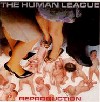 1979's Reproductionis the first full-length LP by The Human League, following some 12"singles and EPs released the year before. The reissue treatment fullyremasters and restores the sound, as well as adding loads ofsupplemental material, including the ultra-rare The Dignity of Labour EP and their first single Being Boiled. Reproductionfinds the group in pristine form, matching dark, futuristic lyrics withmechanized beats, icy synth melodies and keyboard swooshes. PhilOakey's lyrics elaborate on his childish, science-fiction obsessionwith an apocalyptic view of the future. The second track "Circus ofDeath" is a rambling, surreal narrative about a future holocaustperpetrated by narcotized clowns. Fans of early Gary Numan classicssuch as "Down in the Park" will appreciate this album. All of theelements of the latter day, chart-topping Human League are present, butthe album maintains a consistently arch, clinical distance from thelistener. This is only enhanced by Oakey's wry, detached wit andpassionless delivery. One of Human League's best songs is here, thestrangely upbeat "Empire State Human," a song about avarice and thedesire to attain superhuman powers, set against a relentlessproto-electro beat. By far the strangest track, "Morale," begins withsome ambient synthesizer arpeggios, reminiscent of Tangerine Dream.Philip Oakey pipes in with some mournful lyrics, and the song slowlysegues into an absurdly overproduced cover of The Righteous Brothers'"You've Lost That Loving Feeling." I'm not sure what the League werethinking here, but it somehow works. The Dignity of Labourfunctions as a four-part tribute to early electronic pioneers likeMorton Subotnick, Raymond Scott and Bernard Parmegiani. It's completelyinstrumental, and consists of a series of musique concrete soundscapes.As such, it is the most avant-garde recording that The Human Leagueever released. Tacked onto the end of this re-release is The HumanLeague's first single, "Being Boiled (Fast Version)." I won't go into adescription of this song as it is has popped up on at least 20compilations in just the past year. This version has the exact sametempo as every other version of the song I've heard, so I'm not surewhat makes this a "fast" version, however. Reproduction is essential listening for anyone getting into The Human League or the Sheffield post-punk scene.
1979's Reproductionis the first full-length LP by The Human League, following some 12"singles and EPs released the year before. The reissue treatment fullyremasters and restores the sound, as well as adding loads ofsupplemental material, including the ultra-rare The Dignity of Labour EP and their first single Being Boiled. Reproductionfinds the group in pristine form, matching dark, futuristic lyrics withmechanized beats, icy synth melodies and keyboard swooshes. PhilOakey's lyrics elaborate on his childish, science-fiction obsessionwith an apocalyptic view of the future. The second track "Circus ofDeath" is a rambling, surreal narrative about a future holocaustperpetrated by narcotized clowns. Fans of early Gary Numan classicssuch as "Down in the Park" will appreciate this album. All of theelements of the latter day, chart-topping Human League are present, butthe album maintains a consistently arch, clinical distance from thelistener. This is only enhanced by Oakey's wry, detached wit andpassionless delivery. One of Human League's best songs is here, thestrangely upbeat "Empire State Human," a song about avarice and thedesire to attain superhuman powers, set against a relentlessproto-electro beat. By far the strangest track, "Morale," begins withsome ambient synthesizer arpeggios, reminiscent of Tangerine Dream.Philip Oakey pipes in with some mournful lyrics, and the song slowlysegues into an absurdly overproduced cover of The Righteous Brothers'"You've Lost That Loving Feeling." I'm not sure what the League werethinking here, but it somehow works. The Dignity of Labourfunctions as a four-part tribute to early electronic pioneers likeMorton Subotnick, Raymond Scott and Bernard Parmegiani. It's completelyinstrumental, and consists of a series of musique concrete soundscapes.As such, it is the most avant-garde recording that The Human Leagueever released. Tacked onto the end of this re-release is The HumanLeague's first single, "Being Boiled (Fast Version)." I won't go into adescription of this song as it is has popped up on at least 20compilations in just the past year. This version has the exact sametempo as every other version of the song I've heard, so I'm not surewhat makes this a "fast" version, however. Reproduction is essential listening for anyone getting into The Human League or the Sheffield post-punk scene.
samples:
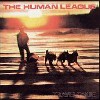 Travelogue is truly a transitional effort, containing both the Kubrickian, technology-obsessed sound that dominated Reproduction, and a healthy dose of the clever, infectious pop that would characterize Dare.The album kicks off with its best song, "The Black Hit of Space," atruly funny/scary song about a 12" from the future that sucks all ofits listeners into a black hole. The music on this track is remeniscentof a lot of the formulaic industrial-style electro and EBM thatdominated the 80's and early 90's. The Human League were pretty muchthe first on the block with this sound, before it had become a hopelessclich?. "Only After Dark" comes on like an electrop Beach Boys song,with its bouncy rhythm and fun vocal harmonies. The rest of the albumis a hit-or-miss affair. Most of the tracks are flawlessly arranged andproduced, but the songwriting is not nearly as strong as the songs on Reproduction or Dare."Being Boiled" also makes an appearance on this album, but it has beenreinvisioned as a hyperactive disco-fied Georgio Moroder track.There are seven extra tracks on this re-issue, most of them fairlydisposable, but fun nonetheless. Who could resist the wackiness oftheir roboticized glam-rock medley of Gary Glitter's "Rock n' Roll" andIggy Pop's "Nightclubbing"? The League also pay homage to theirchildhood science fiction obsession on "Tom Baker," a tribute toeveryone's favorite actor in the role of Doctor Who.
Travelogue is truly a transitional effort, containing both the Kubrickian, technology-obsessed sound that dominated Reproduction, and a healthy dose of the clever, infectious pop that would characterize Dare.The album kicks off with its best song, "The Black Hit of Space," atruly funny/scary song about a 12" from the future that sucks all ofits listeners into a black hole. The music on this track is remeniscentof a lot of the formulaic industrial-style electro and EBM thatdominated the 80's and early 90's. The Human League were pretty muchthe first on the block with this sound, before it had become a hopelessclich?. "Only After Dark" comes on like an electrop Beach Boys song,with its bouncy rhythm and fun vocal harmonies. The rest of the albumis a hit-or-miss affair. Most of the tracks are flawlessly arranged andproduced, but the songwriting is not nearly as strong as the songs on Reproduction or Dare."Being Boiled" also makes an appearance on this album, but it has beenreinvisioned as a hyperactive disco-fied Georgio Moroder track.There are seven extra tracks on this re-issue, most of them fairlydisposable, but fun nonetheless. Who could resist the wackiness oftheir roboticized glam-rock medley of Gary Glitter's "Rock n' Roll" andIggy Pop's "Nightclubbing"? The League also pay homage to theirchildhood science fiction obsession on "Tom Baker," a tribute toeveryone's favorite actor in the role of Doctor Who.
samples:
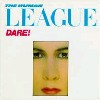 In my humble opinion, Dareis one of the greatest pop albums of all time, and for me it representsthe absolute zenith of the new wave electropop of the early 80's. It isessential listening for fans of the so-called "modern" pop of MagneticFields, The Aluminum Group or any of the new overabundant crop of"electroclash" groups like Ladytron or Soviet. The new digital popmusic characterized by groups like Lali Puna, The Postal Service andTarwater has also been informed by The Human League's unparalleledclassic. Released in 1981, The Human League have by this time lost twoof their founding members, Ian Marsh and Martyn Ware, who left to formthe new wave duo Heaven 17. With Marsh and Ware's departure, HumanLeague have put aside all of the cyber-punk posturing, to focusexclusively on making ten superbly realized, perfect pop songs. Whatresulted is the Human League's masterpiece, one of the rare albumswhere each and every track is a great song in its own right. PhilipOakey's lyrics contain decidedly more "human" themes this time around,with some very grown-up songs about lost love, the modern world, murderand "the law." The production is a true marvel, gleaming and seamless."The Things That Dreams are Made Of" kicks off the record with abeautiful synth melody and flawless drum programming. Soon, Oakey isreading off an inspired list of the things that his dreams are made of:"New York, ice cream, TV, travel, good times, Johnny, Joey, Dee Dee,good times...". Witty, urbane lyrics and brilliant pop hooks abound onthis record. Things take a rather disturbing turn with the somber,darkwave track "Seconds," which is as dead serious as The Human Leagueget. The album ends with The Human League's biggest hit, and also oneof their best songs, "Don't You Want Me," with its he said/she saidlyrics and infectiously catchy chorus. If you thought this was justmindless 80's flashback music, listen again. As a bonus with Caroline'sreissue, the entire Love and Dancing LP has been included.Originally credited to The League Unlimited Orchestra (in a tribute toBarry White's instrumental side-project), Love and Dancing is one of the first examples of a true remix album. Seven tracks from Dareand one extra track are specially remixed by producer Martin Rushent,whose liberal use of echo and a complement of wacky sound effects andintrumental fills is immediately reminiscent of the early dub approachto remixing. Love and Dancing is quite a sought-after rarity on LP, so to have these tracks available on this re-release is a real treat.
In my humble opinion, Dareis one of the greatest pop albums of all time, and for me it representsthe absolute zenith of the new wave electropop of the early 80's. It isessential listening for fans of the so-called "modern" pop of MagneticFields, The Aluminum Group or any of the new overabundant crop of"electroclash" groups like Ladytron or Soviet. The new digital popmusic characterized by groups like Lali Puna, The Postal Service andTarwater has also been informed by The Human League's unparalleledclassic. Released in 1981, The Human League have by this time lost twoof their founding members, Ian Marsh and Martyn Ware, who left to formthe new wave duo Heaven 17. With Marsh and Ware's departure, HumanLeague have put aside all of the cyber-punk posturing, to focusexclusively on making ten superbly realized, perfect pop songs. Whatresulted is the Human League's masterpiece, one of the rare albumswhere each and every track is a great song in its own right. PhilipOakey's lyrics contain decidedly more "human" themes this time around,with some very grown-up songs about lost love, the modern world, murderand "the law." The production is a true marvel, gleaming and seamless."The Things That Dreams are Made Of" kicks off the record with abeautiful synth melody and flawless drum programming. Soon, Oakey isreading off an inspired list of the things that his dreams are made of:"New York, ice cream, TV, travel, good times, Johnny, Joey, Dee Dee,good times...". Witty, urbane lyrics and brilliant pop hooks abound onthis record. Things take a rather disturbing turn with the somber,darkwave track "Seconds," which is as dead serious as The Human Leagueget. The album ends with The Human League's biggest hit, and also oneof their best songs, "Don't You Want Me," with its he said/she saidlyrics and infectiously catchy chorus. If you thought this was justmindless 80's flashback music, listen again. As a bonus with Caroline'sreissue, the entire Love and Dancing LP has been included.Originally credited to The League Unlimited Orchestra (in a tribute toBarry White's instrumental side-project), Love and Dancing is one of the first examples of a true remix album. Seven tracks from Dareand one extra track are specially remixed by producer Martin Rushent,whose liberal use of echo and a complement of wacky sound effects andintrumental fills is immediately reminiscent of the early dub approachto remixing. Love and Dancing is quite a sought-after rarity on LP, so to have these tracks available on this re-release is a real treat.
samples:
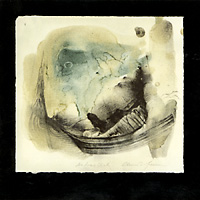 There are a number of reasons I love vinyl and strongly advocate vinyl usage: it actually -does- sound better for louder recordings with the whole signal-to-noise ratio thing; it comes with pretty big pictures if you're lucky; DJs (and those who think they are) can match beats, scrach and mix; and idiot roommates/junkie friends/random thieves rarely steal it as it's too big and heavy and used stores hate to sell used vinyl. However, let me go on record as saying that for quieter, more meditative recordings, I would prefer the usage of vinyl be very limited (if not eliminated). Every time a record is pulled out of its protective sleeve, thousands of microscopic particles collect—this is inevitable. With the more quiet recordings, the buildup of particles in the grooves is audibly evident. Mirror recordings are all lengthy soundscapes, gently combining musical and non-musical sound sources over long periods of time, with startlingly hypnotic effects. The difference in hearing a vinyl recording of the very first Mirror album released on record and the CD which was issued last week is absolutely amazing.
There are a number of reasons I love vinyl and strongly advocate vinyl usage: it actually -does- sound better for louder recordings with the whole signal-to-noise ratio thing; it comes with pretty big pictures if you're lucky; DJs (and those who think they are) can match beats, scrach and mix; and idiot roommates/junkie friends/random thieves rarely steal it as it's too big and heavy and used stores hate to sell used vinyl. However, let me go on record as saying that for quieter, more meditative recordings, I would prefer the usage of vinyl be very limited (if not eliminated). Every time a record is pulled out of its protective sleeve, thousands of microscopic particles collect—this is inevitable. With the more quiet recordings, the buildup of particles in the grooves is audibly evident. Mirror recordings are all lengthy soundscapes, gently combining musical and non-musical sound sources over long periods of time, with startlingly hypnotic effects. The difference in hearing a vinyl recording of the very first Mirror album released on record and the CD which was issued last week is absolutely amazing.
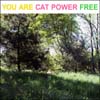 Without the assistance of over-the-top production, Chan Marshall has managed to craft one of the best albums I've heard this year. Her fifth album (sixth counting The Covers Record) is an amazing adventure through the sounds of loneliness, resignation, memory, and empowerment.
Without the assistance of over-the-top production, Chan Marshall has managed to craft one of the best albums I've heard this year. Her fifth album (sixth counting The Covers Record) is an amazing adventure through the sounds of loneliness, resignation, memory, and empowerment.
I drove six hours through ten inches of snow for this one and it was worth it.
It was an intimate show, probably about 18 people, what with it being below zero and a Monday night in Omaha. I almost didn't recognize Virgil as he's thinner and his hair is shaggier and blonder than I remember from the 2001 Angels of Light tour, which is how I first became aware of the San Francisco singer/songwriter and Dieselhed frontman. He played acoustic guitar miked through a small practice amp and was joined by Marc Capelle on piano, backing vocals and occasional flugelhorn. As expected the 45 minute set was primarily from the new album 'Still Falling' and included all of my favorites: "The Drawing", "Golden Sun", "Wilderness of This World", "Still Falling", "Water Color" and "Volvo" (both from the previous album, 'Quad Cities', Shaw's solo debut), plus two more I was particularly taken with, the Bee Gees' "Country Lanes" and a new one, "Logger's Daughter". His songs fall loosely into the alt-country vein and the quirky physicality of his guitar playing matches the closed-eyed intensity of his unique vocals.
John Doe did a couple songs solo then the rest of the trio joined him, Dave Carpenter on stand-up bass and backing vocals and Nick Luca on piano and occasional guitar. They played nearly all of last year's new album, 'Dim Stars, Bright Sky', which was exactly what I wanted. There were several older songs I didn't really recognize and three classic X songs: "White Girl", "Burning House of Love" and another that I've since forgotten, other than they did a "country" version of it. John joked that if he ever ended up in Branson to "please shoot me". He was very congenial and funny all night, having a conversation with us between every song, which made for the same sort of vibe Mark Eitzel can conjure up on a good night. "Highway 5" became "Highway 80" since they had broken down on it earlier in the day and several people stopped to ask if they needed help. There were two encores and the last song was a request for "Take 52" from Doe's solo debut 'Meet John Doe'. John said "I don't think they're going to like that one" pointing to the three late arriving punk rock kids (everyone else was "normal" looking, most easily in their 30s and up) at the table down front and played it anyways. Their whole set was about one hour and 20 minutes. Don't worry John, you won't end up in Branson anytime soon. But you will end up on the East coast and in the South, with and without Virgil, through the rest of March. Check virgilshaw.com or thejohndoe.com for all the dates.
Go back, go back: its just like punk rock happened, and then happened again and again. Ikara Colt are a bunch of former art student poseurs who act like they spent hours watching '77 punk footage and striking poses in front of the mirror. If they haven't assimilated, regurgitated, and morphed the shtick of The Fall, then I'm a valium kiche kiche. The bassist wears a school unifom a size too small and acts the poxy epileptic whilst the singer is a southern Mark Smith, spitting a-caustic. The guitarist moves like Karren Ablaze's little sister as she keeps her fretfire burnin'. What do you mean, "Who's Karren Ablaze?" The beers kicks in and I'm possessed by the rancid spectre of Mark E Smith. Two people in a room turn into the most hideous replicas: whilst the singer pulls the young vicious Smith moves I can't stop the joke the joke (after five years in my own PC camp): a heckler spray of Smithisms. The band have finely paced their set, ratcheting up the energy with every consecutive anti-hit. In the end the singer dedicates the last and best number, a new one, to the Rowche Rumbler who's been pointing out the obvious. In the bar members of Manchester garage punkers Jackie O and the Strap Ons are milling through the grinder. "It's showtime," shouts the friendly doorman and Yeahs Yeahs Yeahs seize their time, tour sold out before an album even dropped. First up is the almost genius love-envy song "Maps" extended to extrude salivating anticipation. Many lesser bands would've shot their bolt blasting out the total genius guitar noise pop feast "Why Control?" next. An as yet unreleased gem premiered on their Peel session, its the bastard lovechild of "Drunken Butterfly" and "Passing Complexion" but catchier. The lyrics are simple brilliance and simply brilliant. Are they a nod to Burroughs? How novel for a New York group, the detractors sneer, but its their loss. Karen O sings like a punked up Dolly Parton with a vibrator up her and moves like a trash poseur who doesn't have to look in a cracked mirror. None of the three Yeahs are replaceable parts, and guitarist Nick Zinner has such a great chimecrush crescendo onslaught there's no missing the bass. Predictable that the single "Machine" gets the kids bouncing perhaps, but another new number is an instant foot hit. Yeah Yeahs Yeahs are going to be the biggest rock band since Nirvana, easy. I was there then and I know what I'm talking about, kid. Is it their time to be hated? No, Libertines are the fuckin' enemy. Useless diluters can go piss up a rope. They look like shit!
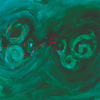 By now, the house lights have come up, the violinist has left with somegirl, the drummer is loading up his truck, and a lone guitaristcontinues on. If Dirty Three is appropriate for the late, late night,Mick Turner's music is most definitely appropriate for after, afterhours. Like other Mick Turner albums, Mothis a collection of numerous short but pretty pieces. This time around,there's 19 untitled parts. While it lacks the more solid songstructures with Tren Brothers and Bonnelvill releases, the expectantbeauty and variety has remained. Turner's instrument is simply theguitar and rarely something more. With the use a looping pedal, layersare added, removed, played with and reversed to make beautiful guitarcollages. Mike Krassner (Boxhead Ensemble, Edith Frost, Pinetop Seven),who co-produced the album joins up on piano by "Part 5," and appears onpiano for a number of parts thereafter, until, by "Part 18," (I thinkit's mis-labelled on the sleeve) they're joined on organ by RyanHembrey (also of the Boxhead Ensemble, Edith Frost, and Pinetop Seven).While the songs are delicate and gorgeous, I would probably recommendthis album only for existing fans, as other fantastic introductions toMick Turner's work would include music as Bonnelvill with Jessica Bileyon violin and piano or being fortunate enough to catch him live wherehe blissfully lets the songs drift for great lengths.
By now, the house lights have come up, the violinist has left with somegirl, the drummer is loading up his truck, and a lone guitaristcontinues on. If Dirty Three is appropriate for the late, late night,Mick Turner's music is most definitely appropriate for after, afterhours. Like other Mick Turner albums, Mothis a collection of numerous short but pretty pieces. This time around,there's 19 untitled parts. While it lacks the more solid songstructures with Tren Brothers and Bonnelvill releases, the expectantbeauty and variety has remained. Turner's instrument is simply theguitar and rarely something more. With the use a looping pedal, layersare added, removed, played with and reversed to make beautiful guitarcollages. Mike Krassner (Boxhead Ensemble, Edith Frost, Pinetop Seven),who co-produced the album joins up on piano by "Part 5," and appears onpiano for a number of parts thereafter, until, by "Part 18," (I thinkit's mis-labelled on the sleeve) they're joined on organ by RyanHembrey (also of the Boxhead Ensemble, Edith Frost, and Pinetop Seven).While the songs are delicate and gorgeous, I would probably recommendthis album only for existing fans, as other fantastic introductions toMick Turner's work would include music as Bonnelvill with Jessica Bileyon violin and piano or being fortunate enough to catch him live wherehe blissfully lets the songs drift for great lengths. 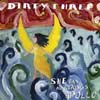 It's late and the bartender has announced last call. Tonight wasfantastic, as a number of singers graced the stage to stand in thespotlight, whether it was an ex junkie, a rich hick with a spookybeard, an overemotional freaky chick, or a cute male/female duo whoharmonize beautifully well. The parade of stars has come and gone. Thecrowd has been reduced to the small number of staff and a couple otherswho similarly are just trying to let the world stop spinning. On stage,the trio that sat in the back are still playing quietly. A triangularsymmetry is met by the lonely violinist, shuffling drummer andreflective guitarist. Only now does it make sense that while thesefolks can back up a variety of egos, their knowledge of, attraction to,and attention in which they pay each other is truly remarkable. WarrenEllis, Mick Turner, and Jim White have been playing as Dirty Three foryears, and with each album, it seems their bond grows stronger. Whetherit's with the driving force of "She Has No Strings," the quiet pianoand malleted-drums of "Long Way to Go with No Punch," or the pluckedviolins on "No Stranger Than That," they demonstrate that like anygreat ensemble, there is never one member who is more or less importantthan the other. Sure, they take turns leading the group here and there,like the unexpected fuzz guitar on "Rude (and then some slightreturn)," the mad drum solo on "No Sister Let Them Try and Follow," andthe multiple-layered violins on "She Lifted the Net." Dirty Three areone of the most reliably consistent bands and I have never been letdown by any of their records. Furthermore, it's always an extra specialtreat to see any of them live together, alone, or with others, and I'mhappy that it seems like they're always on the road in some band oranother.
It's late and the bartender has announced last call. Tonight wasfantastic, as a number of singers graced the stage to stand in thespotlight, whether it was an ex junkie, a rich hick with a spookybeard, an overemotional freaky chick, or a cute male/female duo whoharmonize beautifully well. The parade of stars has come and gone. Thecrowd has been reduced to the small number of staff and a couple otherswho similarly are just trying to let the world stop spinning. On stage,the trio that sat in the back are still playing quietly. A triangularsymmetry is met by the lonely violinist, shuffling drummer andreflective guitarist. Only now does it make sense that while thesefolks can back up a variety of egos, their knowledge of, attraction to,and attention in which they pay each other is truly remarkable. WarrenEllis, Mick Turner, and Jim White have been playing as Dirty Three foryears, and with each album, it seems their bond grows stronger. Whetherit's with the driving force of "She Has No Strings," the quiet pianoand malleted-drums of "Long Way to Go with No Punch," or the pluckedviolins on "No Stranger Than That," they demonstrate that like anygreat ensemble, there is never one member who is more or less importantthan the other. Sure, they take turns leading the group here and there,like the unexpected fuzz guitar on "Rude (and then some slightreturn)," the mad drum solo on "No Sister Let Them Try and Follow," andthe multiple-layered violins on "She Lifted the Net." Dirty Three areone of the most reliably consistent bands and I have never been letdown by any of their records. Furthermore, it's always an extra specialtreat to see any of them live together, alone, or with others, and I'mhappy that it seems like they're always on the road in some band oranother.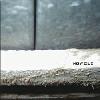 Vivo is a primarily electronic label based in Poland with six releases to date, including the recommended Black Faction remix album 'Reworked.' With this compilation, they present 49 minutes worth of "narrative sonic stories," ("nowele" is Polish for "short stories") by little known but impressive artists from the US, Poland and Japan. "Uruk," by Maciek Szymczuk sets a rhythmic foundation of pops and gelatinous warbles as a lucid two note ping makes for melody.
Vivo is a primarily electronic label based in Poland with six releases to date, including the recommended Black Faction remix album 'Reworked.' With this compilation, they present 49 minutes worth of "narrative sonic stories," ("nowele" is Polish for "short stories") by little known but impressive artists from the US, Poland and Japan. "Uruk," by Maciek Szymczuk sets a rhythmic foundation of pops and gelatinous warbles as a lucid two note ping makes for melody.



